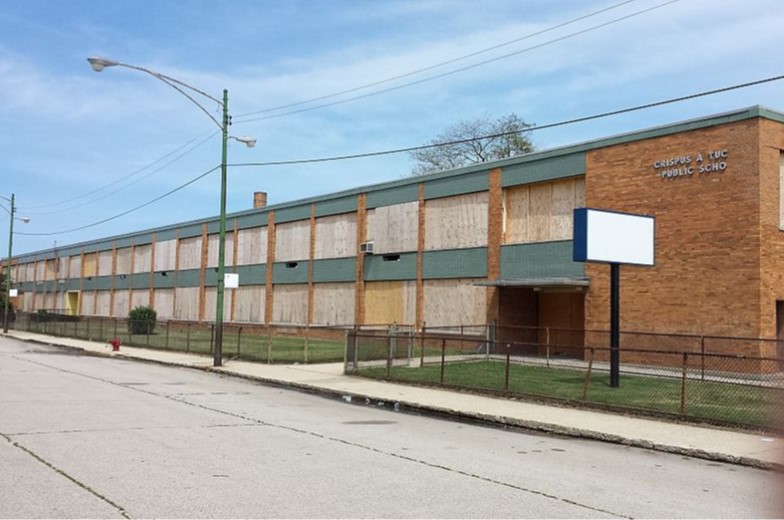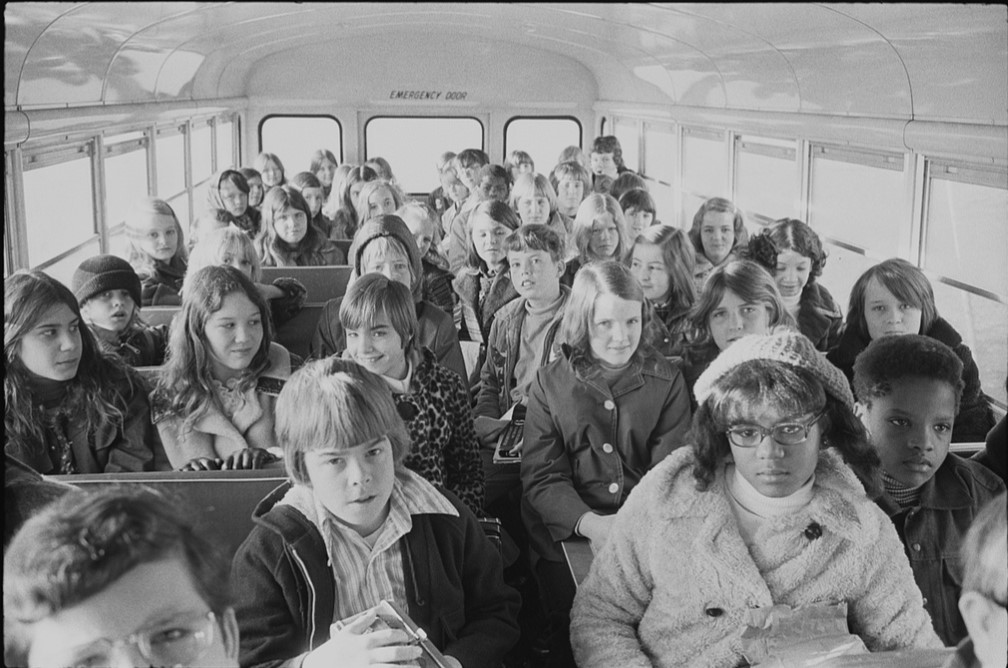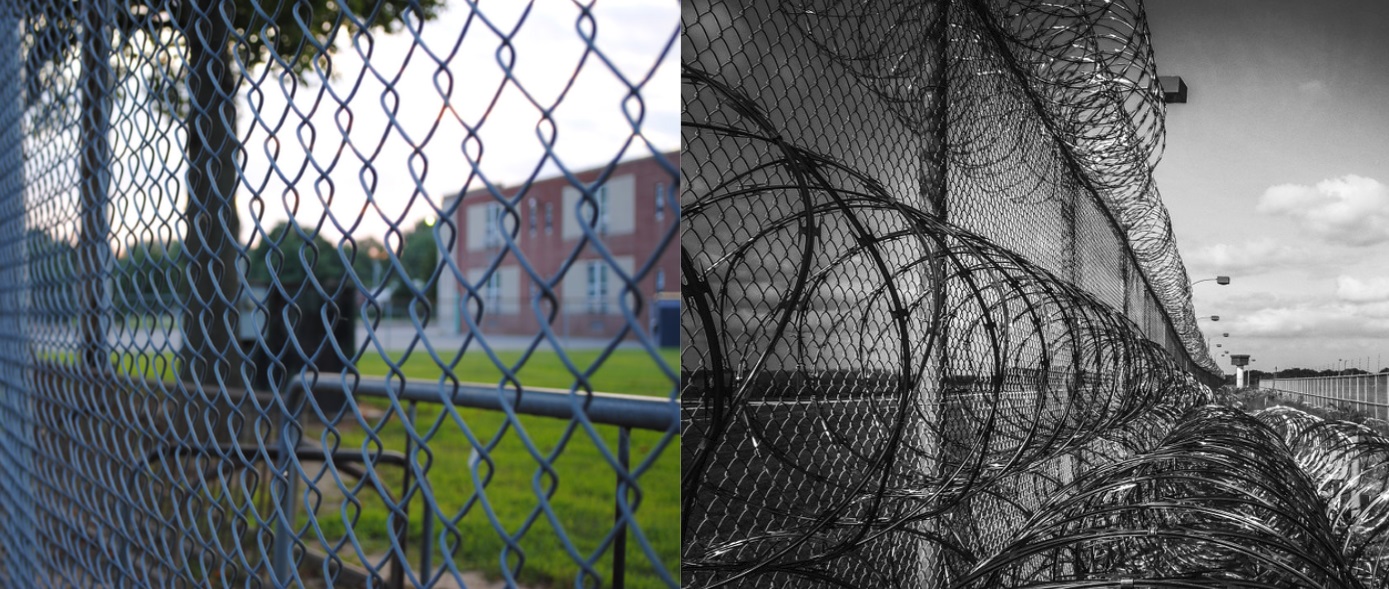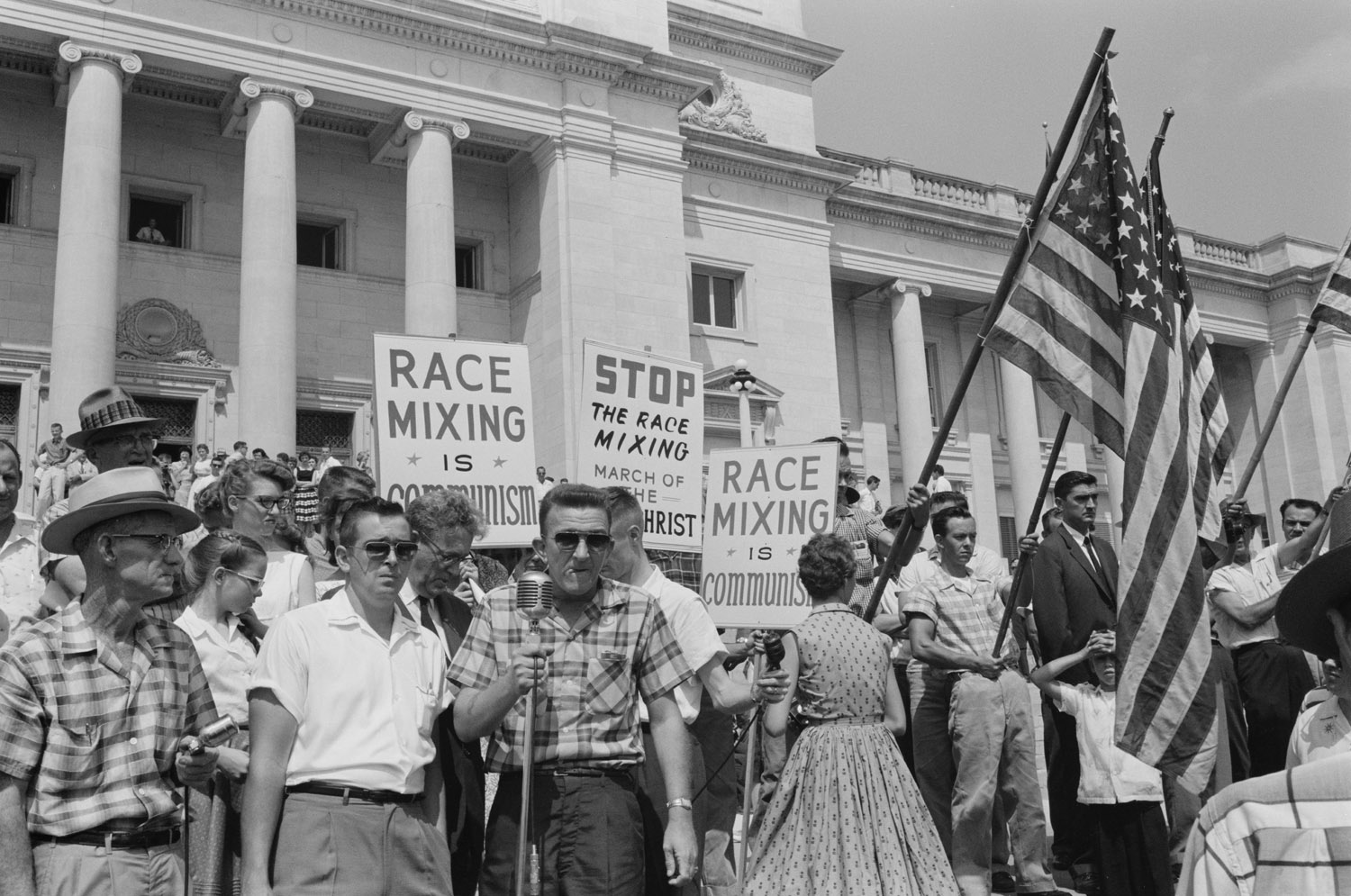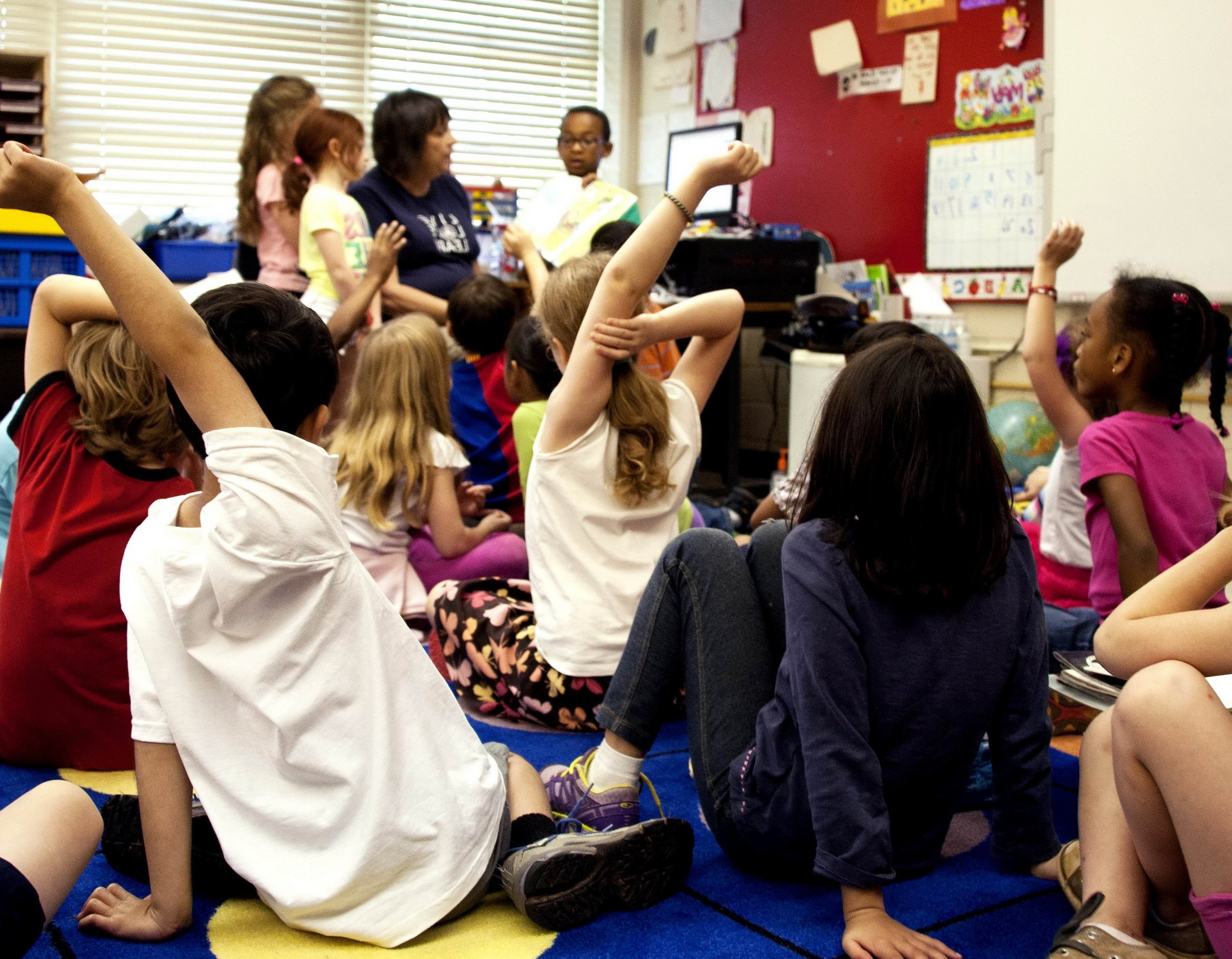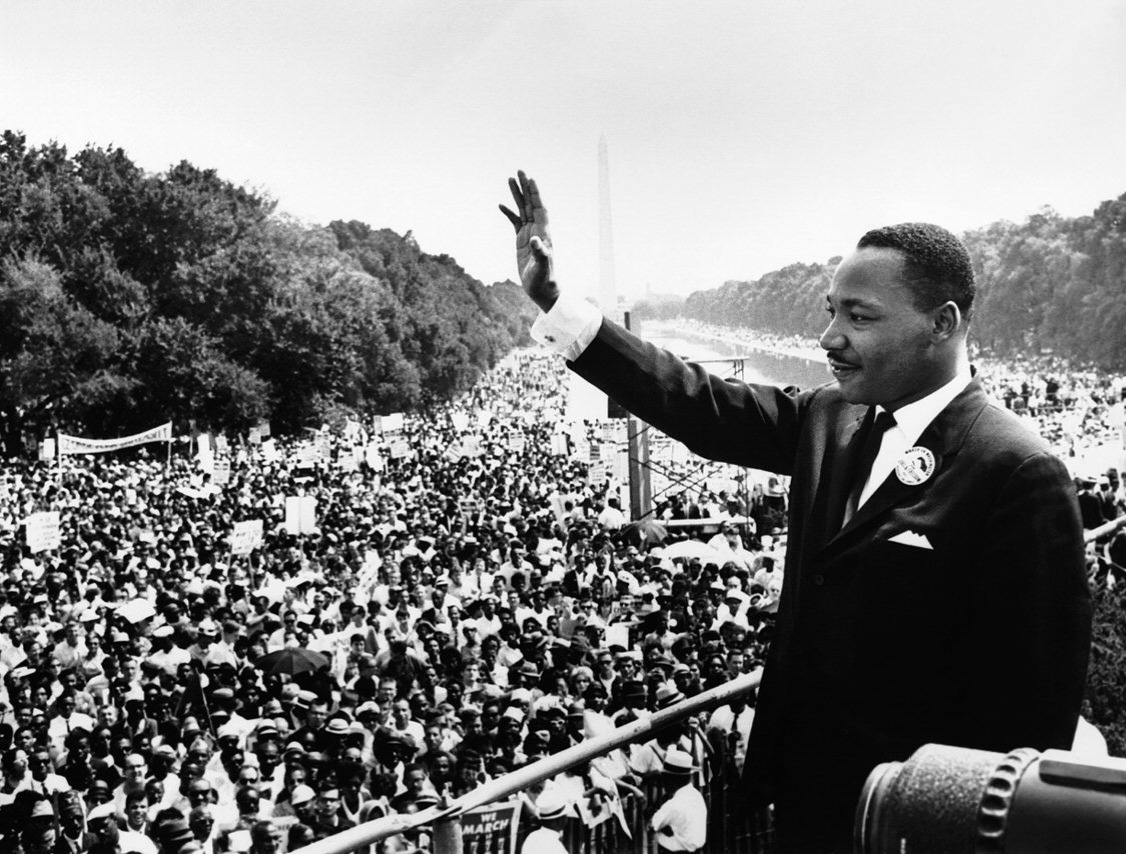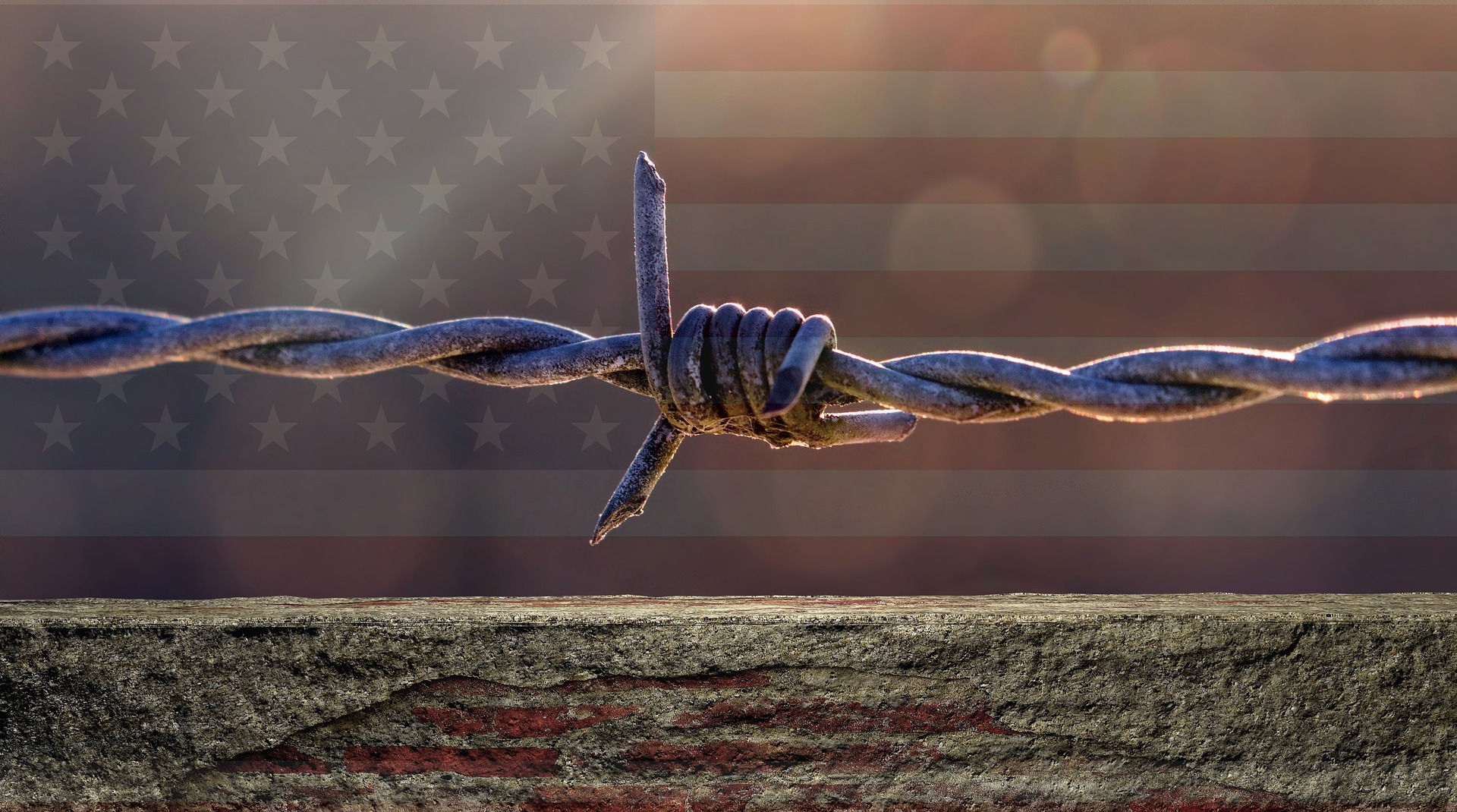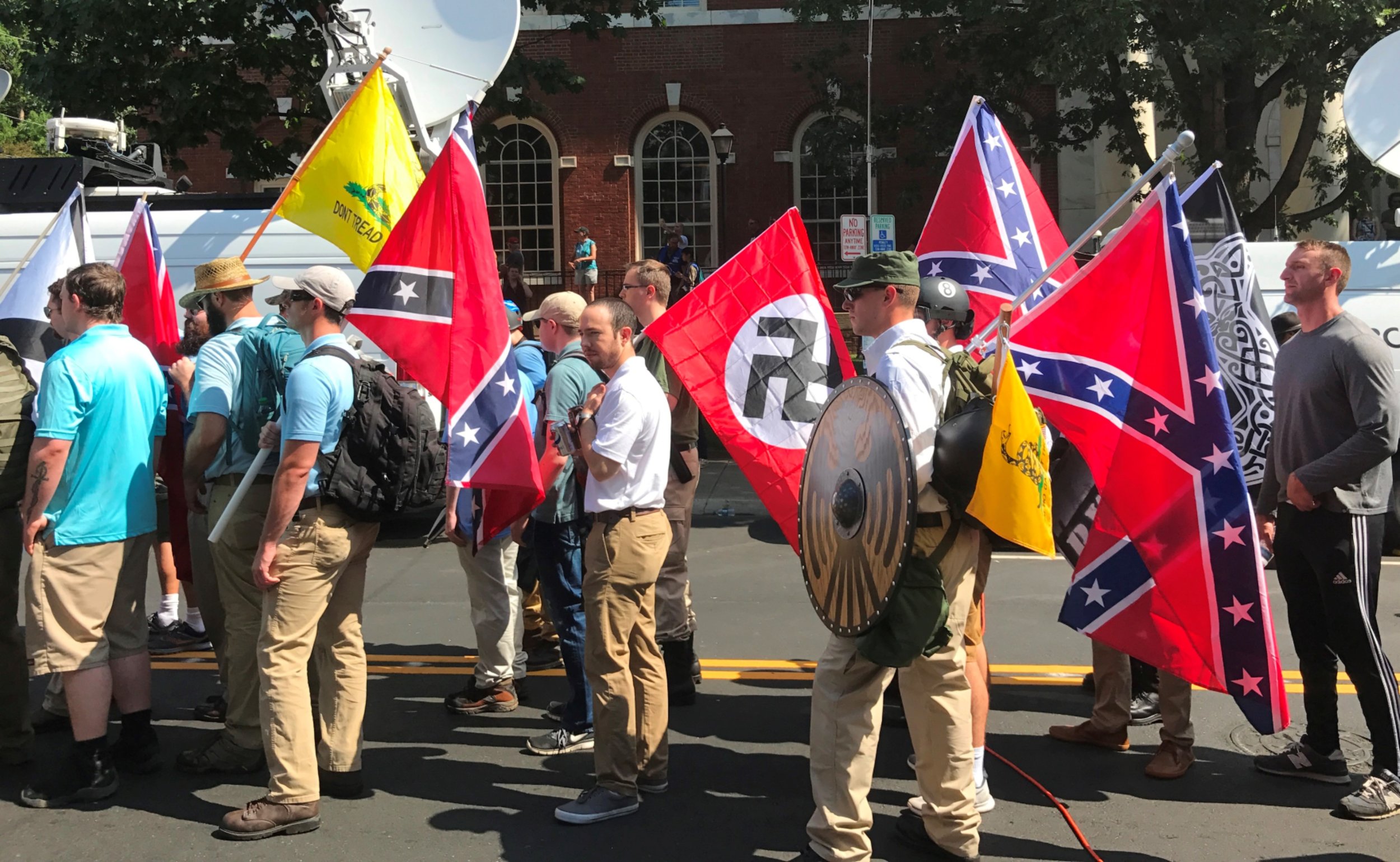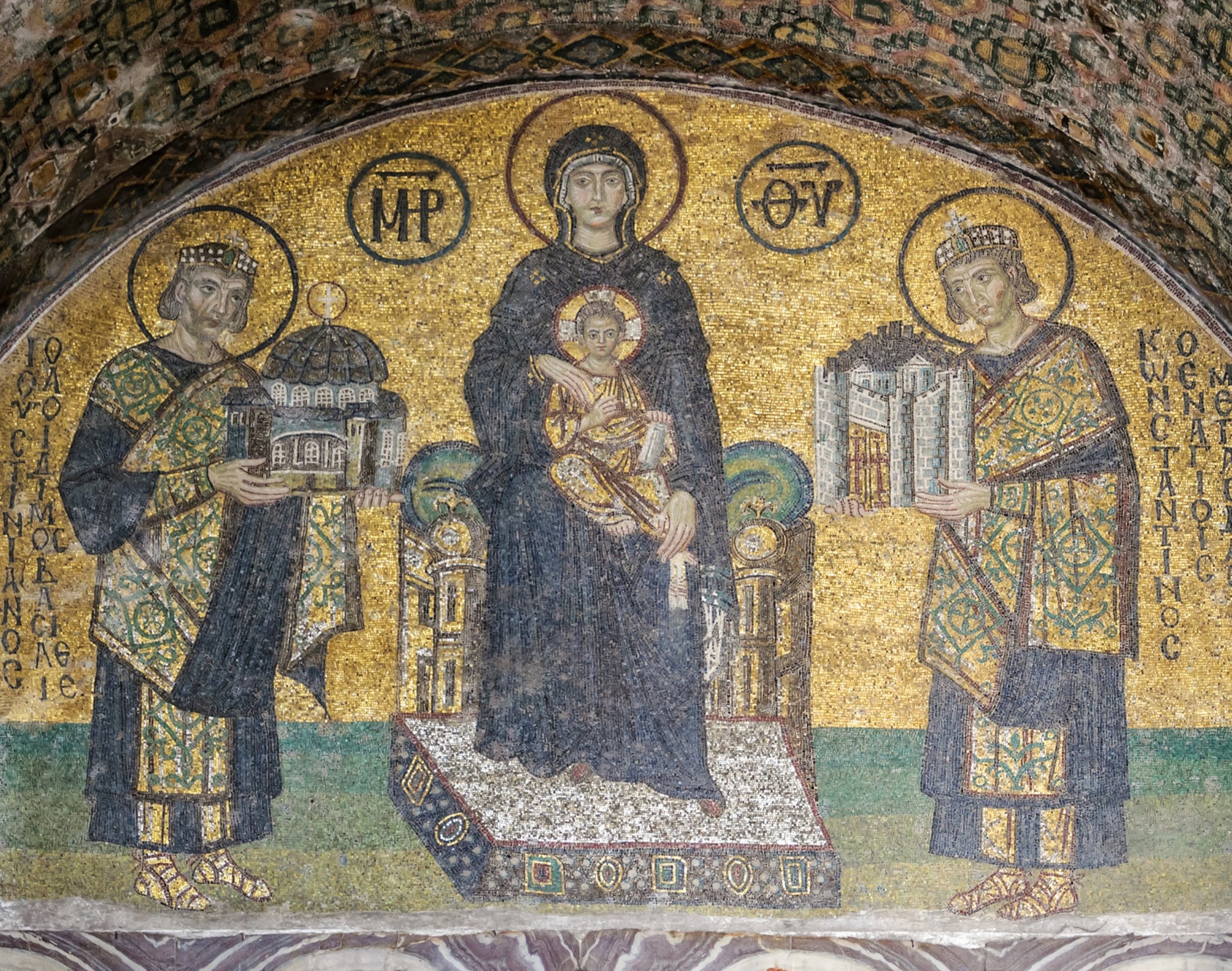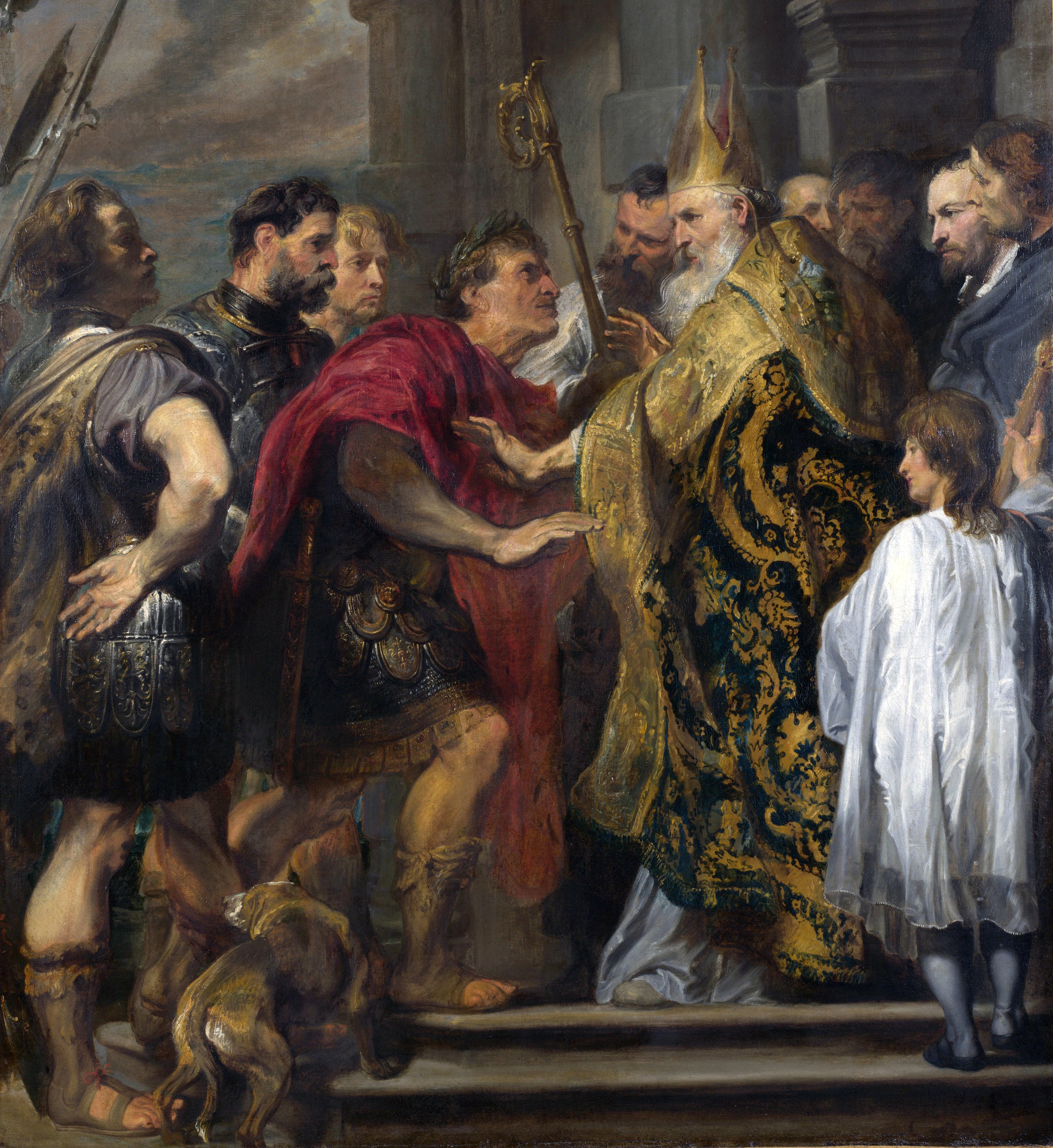Race and School Inequalities
Photograph: The Crispus Attucks Public School in Chicago, IL, closed as of August 8, 2013 when this picture was taken. As of 2017, according to AJ+, Inside Chicago Part 2: The Racist History of Chicago's Housing Policies (AJ+, May 25, 2017) Chicago Public Schools is the country's fourth largest school district, 9% are white; most are black and Latino. It has 20% of Illinois students, but receives only 15% of its education funding. Photo credit: Steven Kevil | CC3.0, Wikimedia Commons.
Introduction
Schooling inequalities cause opportunity gaps for students, which is especially apparent by race.
Messages and Resources on Race and Schooling Inequalities
Sangwon Yang and Mako Nagasawa, The Myth of Meritocracy in Schooling, Part 1
The Anastasis Center Blog, Nov 12, 2018. A 10 minute read. This post highlights the impact of resource inequality on educational outcomes and student experience. As background, see also the two posts about racial segregation in housing: The Myth of Meritocracy in Housing, Part 1 (blog, Nov 3, 2018), and The Myth of Meritocracy in Housing, Part 2 (blog, Nov 5, 2018)
Sangwon Yang and Mako Nagasawa, The Myth of Meritocracy in Schooling, Part 2
The Anastasis Center Blog, Nov 19, 2018. A 10 minute read. This post highlights the impact of resource inequality and racial-cultural dynamics on disciplinary outcomes and student experience.
A small group discussion guide to a few major issues in public schooling, and how church communities can partner with local schools. Topics include: school financing; residential segregation; whether charter schools should be able to fire students; the school-to-prison pipeline; and the honoring of teachers.
Slides to a presentation summarizing the remarkable dignity that Christians perceived in children, who had no inherent dignity or status in pagan Greco-Roman cultures. This impacted views on infanticide, abortion, social welfare, and education. Based on outstanding research by O.M. Bakke, When Children Became People: The Birth of Childhood in Early Christianity.
Christian Restorative Justice: Beyond Charity - God's Restorative Justice for Children and Families
Slides to a presentation glancing at how Christians have historically supported children and their livelihood and development, such as for literacy and against child labor abuse.
Other Resources on Schooling Inequalities and the Opportunity Gap
Responses to Conservative Arguments Blaming Black Culture and Black Families for Underachievement:
Michael Hansen and Diana Quintero, Analyzing ‘the Homework Gap’ Among High School Students. Brookings Institute, Aug 10, 2017. Noteworthy as a study because of how statistics like this are used by conservatives to indicate that the root of black underachievement is the culture of the black family. While the study finds that controlling for in-family factors like working, needing to care for family members, and parental education, the gap persists. The study acknowledges, however, that there were factors that were not studied, among which I list: parental word use from ages 0 - 4; early childhood education and experiences, which are much more impactful statistically; expectations of high school teachers; quality of high school experience. The study also does not control for neighborhood quality: crime and other forms of stress; peer group dynamics; poverty as a two or three generation family experience rather than an episodic one; availability of video games, even, because video games are an addictive substance neurologically. Todd R. Stinebrickner and Ralph Stinebrickner, The Causal Effect of Studying on Academic Performance. NBER, Aug 2007. video games are addictive and impair educational success, which is even more likely after 2007. Richard Rothstein, The Racial Achievement Gap, Segregated Schools, and Segregated Neighborhoods – A Constitutional Insult. Economic Policy Institute, Nov 12, 2014. provides a thorough, data-driven analysis. Intergenerational effects of poverty on the family are a significant variable.
Not only that, poverty itself causes stress and adversity that affects the brain. See Allison Eck, Stress from Poverty Decreases Child Brain Sizes - Even at Birth. PBS, Mar 31, 2015. Trace Dominguez, How Poverty Changes Your Brain. Test Tube video, Apr 22, 2015. Tara Garcia Mathewson, How Poverty Changes the Brain. The Atlantic, Apr 19, 2017. Those who are higher achieving may bear in their bodies the accumulated stress of high achievement in ways others do not. Dr. Gene Brody in his 1997 - 2001 Pittsburgh study found that those people who were “more diligent and tended to strive for success” were more likely to get sick. James Hamblin, Why Succeeding Against the Odds Can Make You Sick. New York Times, Jan 27, 2017. summarizes several more years of research by Brody et al. who found that “white blood cells among strivers were prematurely aged relative to those of their peers. Ominous correlations have also been found in cardiovascular and metabolic health. In December, Dr. Brody and colleagues published a study in the journal Pediatrics that said that among black adolescents from disadvantaged backgrounds, “unrelenting determination to succeed” predicted an elevated risk of developing diabetes.” Biologically, this is related to childhood adversity and elevated levels of cortisol, a stress hormone. “Constantly bathing cells in stress hormones, the science would suggest, could sponsor more inflammatory responses,” Dr. Brody offered, potentially leading to autoimmune disorders like diabetes. Of course, nothing about adrenaline or DNA expression should be unique to people with high levels of melanin in their skin. Why would white people appear to be immune?” The patients’ racial background question was relevant to the researchers because, very significantly, lower-income white people seemed unaffected by poverty alone; they were undifferentiated from higher-income white people. Another researcher, Dr. Mahasin Muhajid, concluded “that because African-Americans encounter more overt and systemic discrimination, “the combination of adversity and high-effort coping is what’s having health consequences.” Benjamin Weiss, African Americans Don’t Sleep As Well as Whites, an Inequality Stretching Back to Slavery. Los Angeles Times, Apr 23, 2017. Weiss points out the cost in health as measured by the “sleep gap”: Fewer black people are able to sleep for the recommended six to nine nightly hours than any other ethnic group in the United States; compounding matters, a smaller percentage of African Americans’ slumber is spent in “slow-wave sleep,” the deepest and most restorative phase of sleep that produces the most benefits in healing and cognition. Poor sleep has cascading effects on racial health disparities, including increased risk of diabetes and cardiovascular disease. The racial sleep gap is largely a matter of unequal access to safe, reliable and comfortable sleep environments, and this sleeping inequality has a long history. For centuries, whites have tacitly accepted — and even actively created — such inequality . . An ongoing study by psychologist Tiffany Yip of Fordham University examines the joint effects of ethnic discrimination and sleep deprivation on African American and Latino youth; her preliminary findings suggest a vicious cycle in which experiences of discrimination lead to poor sleep, which in turn leads to higher levels of anxiety, lower engagement in school and deepening problems of self-esteem.”
General Resources
Wikipedia, Milliken v Bradley (Wikipedia article) the 1974 SCOTUS case in Michigan that made States not responsible for racial composition across school districts, thus allowing States to be complicit with segregation and greatly weakening Brown v Board 1954
Wikipedia, Segregation Academy (Wikipedia article)
Wealth Inequality (Inequality.org)
Employment Barriers Still Block Aboriginals & Visible Minorities: A Canadian Profile of Racial Differences in Education, Employment & Income. Canadian Assn of University Teachers, 2000.
Jonathan Kozol, Shame of the Nation: Restoring Apartheid Schooling in America. Crown Publishing | Amazon page, 2006.
Eric Eckholm, Plight Deepens for Black Men, Studies Warn. New York Times, Mar 20, 2006.
The U.S. Income Gap Triples, 1979 - 2007
Todd R. Stinebrickner and Ralph Stinebrickner, The Causal Effect of Studying on Academic Performance. NBER, Aug 2007. video games are addictive and impair educational success
Gary Orfield, St Louis, School Desegregation and Housing Policy. HTH Video, Jun 11, 2009.
The Racial Gap Increases Fourfold. Institute on Assets and Policy at Brandeis, May 2010.
The U.S. Income Gap Highest Ever. Boston Globe, Sep 28, 2010.
Joe Soss, Richard C. Fording, Sanford F. Schram, Disciplining the Poor: Neoliberal Paternalism and the Persistent Power of Race. University of Chicago Press | Amazon page, Nov 2011.
Valerie Strauss, John Jackson, Pedro Noguera, Why Education Inequality Persists - and How to Fix It. Washington Post, May 16, 2012.
Ary Spatig-Amerikaner, Unequal Education Federal Loophole Enables Lower Spending on Students of Color. American Progress, Aug 2012.
Roland Fryer, Racial Inequality in 21st Century America. David Toney, Harvard Graduate School of Education, Sep 11, 2012. a fascinating exploration from 9 month olds, highlighting the role of parents, schools
Rucker Johnson, The Impact Desegregation Had on Schools. TEDx Talks, Oct 22, 2012. integration had no effect on white students' HS graduation rate, educational attainment, likelihood of incarceration, and career options/earnings; dramatic increase in black students'; and argues that resource levels of those schools, not a better set of peers, was the key
Daniel S. Levine, Schools Resegregate After Being Freed from Judicial Oversight, Stanford Study Shows. Dec 5, 2012.
Nancy Ditomaso, The American Non-Dilemma: Racial Inequality Without Racism. book, 2012.
Craig Steven Wilder, Ebony and Ivy: Race, Slavery, and the Troubled History of America's Universities. Russell Sage Foundation | Amazon page, 2013.
Shukree Tilghman, The March @ 50: Still Segregated. PBS, 2013. interview with Dr. Gary Orfield about integrated and segregated schools
Christian Science Monitor, Racial Bias Feeds the School-to-Prison Pipeline. Apr 1, 2013.
Black Blue Dog, Study: Whites Tend to Hire Their Friends, Explaining Chronic Black Unemployment. Black Blue Dog, Apr 7, 2013.
Laura Gottesdiener, A Dream Foreclosed: As Obama Touts Recovery, New Book Reveals Racist Roots of Housing Crisis. Democracy Now, Aug 6, 2013.
Scott Jaschik, Meritocracy or Bias? White Definitions of Merit and Admissions Change When They Think About Asian Americans. Insider HigherEd, Aug 13, 2013.
Jordan Weissmann, Entrepreneurship: The Ultimate White Privilege? The Atlantic, Aug 16, 2013.
Tiffany M. Gardner, Alec Irwin, and Curtis W. Peterson, No Shelter From the Storm: Reclaiming the Right to Housing and Protecting the Health of Vulnerable Communities in Post-Katrina New Orleans. Health and Human Rights Journal, Aug 29, 2013.
Retro Report, The Battle for Busing. New York Times video, Sep 9, 2013. , a story of America's school integration and what happened when the buses stopped rolling
Chris Hoenig, Study: Modern Racists Live in the Legacy of Slavery. Diversity Inc, Sep 30, 2013.
Jennifer Slate, Why We Send Our Kids to the Poorest Public School. Christianity Today, Oct 7, 2013.
Aboubacar Ndiaye, Black Boys Have an Easier Time Fitting In at Suburban Schools Than Black Girls. The Atlantic, Oct 21, 2013.
Tressie McMillen Cottom, Why Do Poor People "Waste" Money on Luxury Goods? Talking Points Memo, Nov 1, 2013.
Julie J. Park, Black Men at UCLA: The Devastating Effects of Proposition 209. Huffington Post, Nov 18, 2013.
Mark Karlin, The Rage of the Angry White Male Continues Its Battle Against Equality. Truthout, Nov 22, 2013.
Katie McDonough, Three White College Students File Racial Discrimination Complaint Against Professor Over Lesson on Structural Racism. Salon, Dec 2, 2013.
Amanda Machado, Why Teachers of Color Quit. The Atlantic, Dec 23, 2013.
Mychal Denzel Smith, The Effects of Ignoring Systemic Racism. The Nation blog, Jan 27, 2014.
Tanner Colby, The Massive Liberal Failure on Race, Part 1: How the Left's Embrace of Busing Hurt the Cause of Integration. Slate, Feb 3, 2014.
Tanner Colby, The Massive Liberal Failure on Race, Part 2: Affirmative Action Doesn't Work; It Never Did; It's Time for Another Solution. Slate, Feb 10, 2014.
Jacquie Posey, Penn Economist Links "Assortive Mating" and Income Inequality. Penn Current, Feb 13, 2014.
Joy Resmovits, American Schools Are STILL Racist, Government Report Finds. Huffington Post, Mar 21, 2014.
Steven Hsieh, 14 Disturbing Stats About Racial Inequality in American Public Schools. The Nation, Mar 21, 2014. Black students account for 18 percent of the country’s pre-K enrollment, 48 percent with multiple out-of-school suspensions
Sonali Kolhatkar, Studies Confirm the Dehumanization of Black Children and the ‘Preschool-to-Prison Pipeline’. Common Dreams, Apr 4, 2014.
Richard D. Kahlenberg, Affirmative Action Fail: The Achievement Gap by Income is Twice the Gap by Race. The New Republic, Apr 27, 2014.
Liz Dwyer, 6 Shocking Facts About Public School Segregation. TakePart, May 17, 2014.
Ta-Nehisi Coates, The Case for Reparations. The Atlantic, May 21, 2014.
Blair L.M. Kelley, ‘The Case for Reparations’ Reignited an Important and Long-Standing Debate. The Root, May 24, 2014.
eHistory, The Invasion of America: How the U.S. Took Over an Eighth of the World. eHistory, Jun 2, 2014.
Libby Nelson, 3 Maps That Show School Segregation in the US. Vox, Aug 28, 2014. data from 2011-12
Carol Anderson, Ferguson Isn't About Black Rage Against Cops. It's About White Rage Against Progress. Washington Post, Aug 29, 2014.
Pamela Engel, These Maps Show How Segregated Schools Are in Your County. Business Insider, Sep 5, 2014.
Danielle Kurtzleben, White High School Dropouts Are Wealthier Than Black or Latino College Graduates. Vox, Sep 24, 2014.
Quinn Norton, How White People Got Made. Medium, Oct 17, 2014.
Richard Rothstein, The Racial Achievement Gap, Segregated Schools, and Segregated Neighborhoods – A Constitutional Insult. Economic Policy Institute, Nov 12, 2014. provides a thorough, data-driven analysis
Jeff Yang, Harvard Lawsuit is Not What It Seems. CNN, Nov 24, 2014. does affirmative action pit white and Asian against Latino and black?
Kyra, How to Uphold White Supremacy by Focusing on Diversity and Inclusion. Model View Culture, Dec 10, 2014. about political liberalism vs. material justice
Jason Sokol, The North Isn’t Better Than the South: The Real History of Modern Racism and Segregation Above the Mason-Dixon Line. Salon, Dec 14, 2014.
Project Follow Through. National Institute for Direct Instruction, 2015. “was the most extensive educational experiment ever conducted. Beginning in 1968 under the sponsorship of the federal government, it was charged with determining the best way of teaching at-risk children from kindergarten through grade 3. Over 200,000 children in 178 communities were included in the study, and 22 different models of instruction were compared. The communities that implemented the different approaches spanned the full range of demographic variables (geographic distribution and community size), ethnic composition (white, black, Hispanic, Native American) and poverty level (economically disadvantaged and economically advantaged). Parent groups in participating communities selected one approach that they wanted to have implemented, and each school district agreed to implement the approach the parent group selected.”
Christopher Bonastia, The Racist History of the Charter School Movement. Alternet, Jan 6, 2015.
Sharon Lerner, A School District That Was Never Desegregated. The Atlantic, Feb 5, 2015.
Nicholas Kristof, Straight Talk for White Men. New York Times, Feb 21, 2015.
Kenya Downs, Why is Milwaukee So Bad for Black People? NPR, Mar 5, 2015.
Laura Shin, The Racial Wealth Gap: Why A Typical White Household Has 16 Times The Wealth Of A Black One. Forbes, Mar 26, 2015. homeownership #1; education #2; labor markets #3
Lisa Sharon Harper, How Religion Became a Destructive - and Redemptive - Force for 'Black Lives Matter'. Washington Post, Apr 9, 2015.
Robin Diangelo, White America’s Racial Illiteracy: Why Our National Conversation Is Poisoned from the Start. Salon, Apr 10, 2015.
Shaila Dewan, Driver's License Suspensions Create Cycle of Debt. New York Times, Apr 14, 2015.
Jeff Guo, White Parents in North Carolina Are Using Charter Schools to Secede from the Education System. Washington Post, Apr 15, 2015.
Ana Patricia Munoz, et.al., The Color of Wealth in Boston. Federal Reserve Bank of Boston, Apr 27, 2015.
Jailyn Gladney, My 'Colorblind' College Campus is Still Racist. My White Peers Just Don't See It. The Guardian, Jul 2, 2015. about Boston University
Samuel Liu, The Tiger Parents of Silicon Valley: White and Asian Students in CA Schools Self-Segregate. Slate, Jul 20, 2015.
Matthew Yglesias, Want a Good Public Education for Your Kids? Better Be Rich First. Vox, Jul 21, 2015.
Livia Gershon, How Segregation Hurts Kids. JSTOR Daily, Aug 31, 2015. “Educational segregation hurts all kids, white, black, and Hispanic.”
Katherine Reynolds Lewis, Why Schools Over-Discipline Children With Disabilities. The Atlantic, Jul 24, 2015. "Despite the passage of the Americans with Disabilities Act 25 years ago, students with disabilities are still punished at disproportionate rates" including when race is factored in
Nikole Hannah-Jones, The Continuing Reality of Segregated Schools. New York Times Magazine, Jul 31, 2015.
Nikole Hannah-Jones, The Problem We All Live With - Part 1. This American Life WBEZ, Jul 31, 2015. school districts of Normandy and Ferguson, Missouri
Libby Nelson, This American Life Explains Why School Segregation Still Exists - and Is So Hard to Change. Vox, Aug 3, 2015. about racial tensions about school integration in Ferguson and Missouri; why segregation has been rising since 1988
Nikole Hannah-Jones, The Problem We All Live With - Part 2. This American Life WBEZ, Aug 7, 2015. Hartford CT schools integration efforts; interview with Arne Duncan, Secretary of Education
David Edwards, Study: White People React to Evidence of White Privilege by Claiming Greater Personal Hardships. Raw Story, Sep 28, 2015.
Livia Gershom, The Racism of History Textbooks. JSTOR Daily, Oct 20, 2015. “How history textbooks reinforced narratives of racism, and the fight to change those books from the 1940s to the present.”
David Brooks, A Sensible Version of Donald Trump. New York Times, Oct 27, 2015. cites Raj Chetty's study on the impact of neighborhoods and peer groups
Anya Kamenetz, The Evidence That White Children Benefit From Integrated Schools. NPR, Oct 19, 2015.
Gail Heriot, Why Aren't There More Black Scientists? Wall Street Journal, Oct 21, 2015.
Rebecca Klein, Latino School Segregation: The Big Education Problem That No One is Talking About. Huffington Post, Oct 26, 2015.
Carolyn M. Brown, Black Farmers Shut Out Of $10 Billion Medical Marijuana Business. Black Enterprise, Nov 10, 2015.
Janelle Ross, White Americans Long for the 1950's, When They Didn't Face So Much Discrimination. Washington Post, Nov 17, 2015.
Gordon J. Davis, What Woodrow Wilson Cost My Grandfather. New York Times, Nov 24, 2015.
Eula Biss, White Debt: Reckoning for What Is Owed for White Privilege. New York Times, Dec 2, 2015.
Jason A. Grissom and Christopher Reddings, Discretion and Disproportionality: Explaining the Underrepresentation of High-Achieving Students of Color in Gifted Programs. AERA Open, Jan 19, 2016. find that black teachers refer black students to gifted programs at an equivalent rate as white students, but non-black teachers refer black students at one-third the rate. For summary, see Thandisizwe Chimurenga, Black Kids Are Being Kept Out of Gifted Programs: Why Having More Black Teachers Could Help. Daily Kos, Jan 21, 2016. and Anya Kamenetz, To Be Young, 'Gifted' And Black, It Helps To Have A Black Teacher. NPR, Jan 21, 2016. “Only one factor erased this disparity between students: the race of their teachers. Nonblack teachers identify black students as gifted in reading 2.1 percent of the time. Black teachers are three times more likely to identify black students as gifted in reading: 6.2 percent of the time. That's the same rate as for white students, no matter the race of their teacher.”
Ellen Brait, Resume Whitening Doubles Callbacks for Minority Job Candidates, Study Finds. The Guardian, Mar 17, 2016.
Hillary Crosley Coker, Study Shows Women and Minorities Are Punished for Speaking Up About Workplace Diversity. Jezebel, Mar 24, 2016.
Kenya Downs, What 'White Folks Who Teach in the Hood' Get Wrong About Education. PBS News Hour, Mar 28, 2016. critique of short-lived teacher careers
Jack Encarnacao, Educators Claim Racial Bias Exists in BPS Discipline. Boston Herald, Apr 4, 2016.
Robert Reich, What is the Racial Wealth Gap? Inequality Media, Apr 27, 2016.
Alana Semuels, How Segregation Has Persisted in Little Rock. The Atlantic, Apr 27, 2016.
Emily Badger, The One Thing Rich Parents Do for Their Kids that Makes All the Difference. Washington Post, May 10, 2016. is residential segregation
Camila Domonoske, After 50-Year Legal Struggle, Mississippi School District Ordered To Desegregate. NPR, May 17, 2016.
Rachel L. Swarns and Sona Patel, 'A Million Questions' From Descendants of Slaves Sold to Aid Georgetown. New York Times, May 20, 2016.
Victoria M. Masse, Do White People Want Merit-Based Admissions Policies? Depends on Who's Their Competition. Vox, May 22, 2016.
Sarah Carr, Tomorrow's Test. Slate, Jun 5, 2016. there are now more students of color than white students in public schools; implications
Liz Sablich, 7 Findings That Illustrate Racial Disparities in Education. Brookings Institute, Jun 6, 2016.
Nikole Hannah-Jones, Choosing a School for My Daughter in a Segregated City. New York Times Magazine, Jun 9, 2016.
Victoria M. Massie, White Women Benefit Most from Affirmative Action - and Are Among Its Fiercest Critics. Vox, Jun 23, 2016.
Greg Toppo, Black Students Nearly 4x As Likely to Be Suspended. USA Today Jun 7, 2016.
Richard V. Reeves, Why Rich Parents Are Terrified Their Kids Will Fall Into the "Middle Class". Brookings Institute, Jul 12, 2016.
Thomas C. Frohlich, Evan Comen and Michael B. Sauter, Black and White Inequality in All 50 States. 24/7 Wall St, Aug 3, 2016.
Tracey Lam and Jonathan Hui, The High Cost of the Model Minority Myth for Asian and Pacific Islander Americans. Harvard Kennedy School Review, Aug 24, 2016.
Daniel Lombroso, Alia Wong, Can School Integration Make a Comeback? The Atlantic video, Sep 7, 2016.
Jonathan Merritt, Segregation is Still Alive at These Christian Schools. Daily Beast, Sep 18, 2016.
Molly Redden and Jana Kasperkevic, Wage Gap Between White and Black Americans Is Worse Today Than in 1979. The Guardian UK, Sep 20, 2016.
David A. Graham, Shattering Charlotte's Myth of Racial Harmony. The Atlantic, Sep 22, 2016. discusses residential segregation, changes in public school policy
Noel Gutierrez-Morfin, U.S. Court Rules Dreadlock Ban During Hiring Process Is Legal. NBC, Sep 21, 2016. notes also Butler Traditional High School's ban on cornrows, locks, and twists
Nathaniel Hilger, Upward Mobility and Discrimination: The Case of Asian Americans. NBER, Oct 2016.
Collier Meyerson, One of America's 'Best' School Districts is Actually Kind of Racist, Report Says. Business Insider, Oct 26, 2016. Long Beach, CA
John Oliver, School Segregation. Last Week Tonight, Oct 30, 2016.
Rebecca Klein, The Story Of The Chinese Family That First Fought To Desegregate Southern Schools. Huffington Post, Nov 4, 2016.
Michael R. Glass, From Sword to Shield to Myth: Facing the Facts of De Facto School Segregation. Journal of Urban History, Nov 10, 2016. “In an ironic turn of events, school officials, judges, lawmakers, journalists, and ordinary citizens later appropriated the phrase [de facto segregation] to deny responsibility for the color line. Thus, what began as an allegation of racial discrimination ultimately became an impenetrable defense of legal innocence. This article recovers the decade of fierce public debates surrounding northern school desegregation by tracing the evolution of de facto segregation from allegation to defense to myth.”
Radiolab, Inner Voices. Radiolab, Nov 2016. about student performance when gender or race trigger words are used or not
Jeff Guo, The Real Secret to Asian American Success Was Not Education. Washington Post, Nov 19, 2016. and Jeff Guo, The Real Reasons the U.S. Became Less Racist Towards Asian-Americans. Washington Post, Nov 29, 2016.
Kandice Sumner, How America's Public Schools Keep Kids in Poverty. TED Talks, Nov 28, 2016. about the disparities in schooling resources due to segregation, the Supreme Court cases which undid Brown v. Board of Education (1954.
Emily Peck, What Happened When One CEO Decided To Talk Openly About Race. Huffington Post, Dec 12, 2016.
Kevin Cullen, Bostonians of the Year 2016: Kylie Webster-Cazeau and Meggie Noel. Boston Globe, Dec 14, 2016.
Tracy Jan, No, Minority Workers Are Not Taking Jobs Away from White People. Washington Post, Dec 17, 2016.
Ann Owens, How the Rich Wanting the Best for Their Kids is Segregating Our Neighborhood. London School of Economics, Dec 22, 2016.
Chelsea Bailey, You're Fired: Buffalo School Board Moves to Oust Trump Ally Carl Paladino Following Racist Comments About Obamas. NBC, Dec 29, 2016.
Kimberly Yam, Huge Asian-American Wealth Gap Pretty Much Invalidates ‘Model Minority’ Concept. Huffington Post, Jan 4, 2017.
Elise Gould, Racial Gaps in Wages, Wealth, and More: A Quick Recap. Economic Policy Institute, Jan 26, 2017
Elise Gould, 8 Years of the Lilly Ledbetter Fair Pay Act. Economic Policy Institute, Jan 27, 2017.
Peter Coy, The Big Reason Whites Are Richer Than Blacks in America. Bloomberg, Feb 8, 2017.
Adrian Florido, Black, Latino Two-Parent Families Have Half The Wealth Of White Single Parents. NPR, Feb 8, 2017.
Heather Gilligan, After Fleeing the Nazis, Many Jewish Refugee Professors Found Homes at Historically Black Colleges. Timeline, Feb 9, 2017. and were shocked at race relations in the South
Janelle Jones, The Racial Wealth Gap: How African-Americans Have Been Shortchanged Out of the Materials to Build Wealth. Economic Policy Institute, Feb 13, 2017.
Tracy Jan, The Biggest Beneficiaries of the Government Safety Net: Working Class Whites. Washington Post, Feb 16, 2017.
Chris Ladd, Unspeakable Realities Block Universal Health Coverage In The US. Forbes, Mar 13, 2017. on "white socialism"
Tom Loveless, Racial Disparities in School Suspensions. Brookings Institute, Mar 24, 2017.
Kat Chow, 'Model Minority' Myth Again Used As A Racial Wedge Between Asians And Blacks. NPR, Apr 19, 2017. reply to Andrew Sullivan's "two parent home" attribution
Emma Brown, Judge: Mostly White Southern City May Secede from School District Despite Racial Motive. Washington Post, Apr 27, 2017.
Ashley Finigan, A Case for Reparations at the University of Chicago. Black Perspectives, May 22, 2017.
Greg Kaufmann, ‘Against All Odds’ Is Required Viewing for White Progressives. Moyers & Company, May 22, 2017.
Kay Lazar, Milton Academy Students Hold Sit-In Over Bias Concerns. Boston Globe, May 23, 2017.
AJ+, Inside Chicago Part 2: The Racist History of Chicago's Housing Policies. AJ+, May 25, 2017. An 8 minute video on Chicago Public Schools, the country's fourth largest school district, failing its students (9% are white; most are black and Latino). It has 20% of Illinois students, but receives only 15% of its education funding. Further cuts mean cutting social workers and support staff, busing for integration, and resources.
Leah Wright Rigueur, Neoliberal Social Justice: From Ed Brooke to Barack Obama. Items, May 30, 2017. On black capitalism
Jason L. Riley, Why Obama's Presidency Didn't Lead to Black Progress. Manhattan Institute, Jun 17, 2017.
Rebecca J. Rosen, ‘We Have to Have a Massive Revolution in Public Education in the United States’. The Atlantic, Jun 26, 2017. re: Henry Louis Gates and black America
Scott Kurashige, The Fifty Year Rebellion: How the U.S. Political Crisis Began in Detroit. University of California Press | Amazon page, Jul 4, 2017.
Sam Biddle, Facebook's Tough on Terror Talk Overlooks White Extremists. The Intercept, Jul 6, 2017.
Ryan V. Reeves, Dream Hoarders: How the American Upper Middle Class Is Leaving Everyone Else in the Dust, Why That Is a Problem, and What to Do About It. Brookings Institution Press | Amazon page, Jun 13, 2017.
Jon Schwarz, The Incredible Lost History of How "Civil Rights Plus Full Employment Equals Freedom". The Intercept, Jul 17, 2017.
Melinda D. Anderson, Why the Myth of Meritocracy Hurts Kids of Color. The Atlantic, Jul 27, 2017.
Alvin Chang, School Segregation Didn't Go Away. It Just Evolved. Vox, Jul 27, 2017.
Katherine Stewart, What the ‘Government Schools’ Critics Really Mean. New York Times, Jul 31, 2017. points out that evangelicalism in the South was intentionally anti-government (anti-New Deal) and racist, but historical parallels can be overstated even while meaningful, as shown by Andrew Walker, NYT Op-Ed: Parents Who Don’t Send Their Kids To Public Schools Are Racist Theocrats. The Federalist, Jul 31, 2017.
Alana Semuels, Japan Might Be What Equality in Education Looks Like. The Atlantic, Aug 2, 2017.
Vivian Yee, Affirmative Action Policies Evolve, Achieving Their Own Diversity. New York Times, Aug 5, 2017.
Barbara Marcolini and Chris Cirillo, The History of Affirmative Action. New York Times, Aug 5, 2017.
Carol Anderson, The Policies of White Resentment. New York Times, Aug 5, 2017.
Rann Miller, Why the NAACP Said "Enough" to School Privatization. Salon, Aug 9, 2017.
Michael Hansen and Diana Quintero, Analyzing ‘the Homework Gap’ Among High School Students. Brookings Institute, Aug 10, 2017. is noteworthy as a study because of how statistics like this are used by conservatives to indicate that the root of black underachievement is the culture of the black family. While the study finds that controlling for in-family factors like working, needing to care for family members, and parental education, the gap persists. The study says, however, that there are factors that were not studied: parental word use; early childhood education and experiences; expectations of teachers; quality of high school experience. The study also does not control for neighborhood quality: crime and other forms of stress; peer group dynamics; poverty as a two or three generation family experience rather than an episodic one. See Richard Rothstein, Nov 2014, above.
Michael Herriot, 3 Facts That Prove the Reality of White Supremacy. The Root, Aug 18, 2017. (1) black college graduates make less money than white high school dropouts; (2) black schools funded less than white; (3) black unemployment double that of white, controlled for education and experience
Alana Semuels, Trump Administration Puts on Hold an Obama-Era Desegregation Effort. The Atlantic, Aug 30, 2017. rule helped poor Americans move to more expensive neighborhoods with better schools
Sean Illing, "Schools Are Segregated Because White People Want Them That Way". Vox, Oct 26, 2017. An interview with Nikole Hannah-Jones
Sophie Khan and Huixian Li, Stop Pointing to Asian Americans to Downplay Racism at Universities. The Hill, Dec 8, 2017.
Emily Hanford and Alex Baumhardt, What American History Classes Aren't Teaching. The Atlantic, Dec 18, 2017. about Mississippi textbooks and the lack of civil rights education
Rebecca Klein, Schools See Major Uptick In Racial Harassment, New Data Suggests. Huffington Post, Feb 23, 2018.
Donald Yacovone, Teaching White Supremacy: U.S. History Textbooks and the Influence of Historians. Medium, Mar 6, 2018.
Erica L. Green, Why Are Black Students Punished So Often? Minnesota Confronts a National Quandary. New York Times, Mar 18, 2018.
Alvin Chang, Living in a Poor Neighborhood Changes Everything About Your Life. Vox, Apr 4, 2018.
German Lopez, Christina Animashaun, and Javier Zarracina, How America Has — and Hasn’t — Changed Since Martin Luther King Jr.’s Death, in 11 Charts. Vox, Apr 4, 2018. From economic well-being to criminal justice issues, racial inequality is still very real in America.
Isabel Angell and Todd Zwillich, State Education Budgets Across the Country Are in Crisis. Here's Why. The Takeaway WNYC Studios, Apr 6, 2018.
Ariane de Vogue, Trump Judicial Nominee Refuses to Say If Landmark Civil Rights Opinion Was Correctly Decided. CNN, Apr 13, 2018. about Brown v. Board (1954); see also Elie Mystal, Originalists Do Not Think Segregation Was Unconstitutional, And Wish You’d Stop Bothering Them About It. Above the Law, Apr 12, 2018.
Ozan Jaquette and Karina Salazar, Colleges Recruit at Richer, Whiter High Schools. New York Times, Apr 13, 2018.
Noah Smith, How to Reduce the Black-White Wealth Gap. Bloomberg, Apr 23, 2018. features very good household data, although I'm puzzled about his idea that government bonds be used for reparations
George Yancy, The Ugly Truth of Being a Black Professor in America. The Chronicle of Higher Education, Apr 29, 2018.
Paul Heideman, Socialism and Black Oppression. Jacobin Magazine, Apr 2018.
Kristina Rizga, A Witness to the Desegregation—and Resegregation—of America's Schools. The Atlantic, May 1, 2018.
John C. Yang, Affirmative Action Benefits Everyone — Including Asian Americans. Huffington Post, May 14, 2018.
Moriah Balingit, NAACP, Special-Education Advocates Sue Betsy DeVos Over Her Department’s Handling of Civil Rights Cases. Washington Post, Jun 1, 2018. and Angela Helm, Betsy DeVos and the Department of Education Get Sued for Abandoning Discrimination Complaints. The Root, Jun 3, 2018.
James Vaznis, Boston’s Schools Are Becoming Resegregated. Boston Globe, Aug 4, 2018.
Moriah Balingit, Do Children Have a Right to Literacy? Washington Post, Aug 13, 2018. re: lawyers for Detroit Public Schools and their families
Rebecca Klein, The Department Of Education Underreports Allegations Of Racial Discrimination In Schools. Huffington Post, Aug 22, 2018.
Bradley L. Hardy, Trevon D. Logan, and John Parman, The Historical Role of Race and Policy for Regional Inequality. The Hamilton Project, September 2018. notes how white flight to the suburbs drained city centers of jobs, tax revenues for schools, etc.
Lena V. Groeger, Annie Waldman and David Eads, Miseducation: Is There Racial Inequality at Your School? ProPublica, Oct 16, 2018. interactive map showing relative likelihood of white and black students being in an AP class
Paul Bowers, Glenn Smith, Seanna Adcox, Jennifer Berry Hawes, and Thad Moore, Minimally Adequate The Post and Courier, Nov 14, 2018. subtitled "How South Carolina’s ‘minimally adequate’ education system fails too many students" on how white supremacy has played out
Thomas Ultican, Destroy Public Education Forces Retooling for 2019 Tultican blog, Dec 26, 2018. names names, foundations, organizations
Annika Neklason, Elite-College Admissions Were Built to Protect Privilege. The Atlantic, Mar 18, 2019. "Even as selective schools opened their doors to a wider array of applicants in the early 20th century, they put policies in place to maintain the advantages of wealthy white students."
Liza Featherstone and Jessica Blatt, AOC Has Some Advice for Parents. Jacobin Magazine, Mar 19, 2019.
The Damage Report, Congresswoman Calls Our Betsy DeVos' Racism. The Damage Report, Apr 1, 2019. Rep. Katherine Clark (D-MA) challenged DeVos when she appeared to defend Trump's budget cuts to education and decision to rescind Obama era guidance to try to prevent unfair discipline of black students
Greg Huffman, Twisted Sources: How Confederate Propaganda Ended Up in the South’s Schoolbooks. Facing South, Apr 10, 2019. “in part through public school curriculums shaped by the United Daughters of the Confederacy (UDC).”
Afrika Afeni Mills, A Letter to White Teachers of My Black Children. Teaching While White blog, Jun 24, 2019. a teacher’s perspective on teaching
Laura Meckler, Effective But Never Popular, Court-Ordered Busing Is a Relic Few Would Revive. Washington Post, Jul 7, 2019. “In a 1973 Gallup poll, just 9 percent of black respondents chose busing as the best way to achieve school integration from a list of options. The most popular was creating more housing for low-income people in middle-income neighborhoods. Still, when asked directly by Gallup in 1981 whether they favored busing to achieve racial balance in schools, 60 percent of black respondents said yes, compared with 17 percent of whites.”
Nick Hanauer, Better Schools Won’t Fix America. The Atlantic, Jul 2019. “Like many rich Americans, I used to think educational investment could heal the country’s ills—but I was wrong. Fighting inequality must come first.”
Editorial Board, A Plan to Diversify New York’s Segregated Schools. New York Times, Sep 2, 2019. “A commission appointed by Mayor Bill de Blasio has ideas worth considering.”
Dave Roos, The Mendez Family Fought School Segregation 8 Years Before Brown v. Board of Ed. History.com, Sep 18, 2019. “Mexican American families in California secured an early legal victory in the push against school segregation.”
Daniella Silva, Study on Harvard Finds 43 Percent of White Students Are Legacy, Athletes, Related to Donors or Staff. NBC News, Sep 30, 2019. “The number drops dramatically for black, Latino and Asian American students with less than 16 percent each coming from those categories, the study said.”
George Packer, When the Culture War Comes for the Kids. The Atlantic, Oct 2019. “Caught between a brutal meritocracy and a radical new progressivism, a parent tries to do right by his children while navigating New York City’s schools.” An insightful personal narrative of an educated white family and the decisions about schooling and parenting.
Derek Thompson, The Cult of Rich-Kid Sports. The Atlantic, Oct 2, 2019. “A new paper provides stark evidence that Harvard gives preferential treatment to affluent white applicants through legacy preferences and sports recruitment.” See the underlying study by Peter Arcidiacono, Josh Kinsler, and Tyler Ransom, Legacy and Athlete Preferences at Harvard. Duke University, Sep 11, 2019. “Using publicly released reports, we examine the preferences Harvard gives for recruited athletes, legacies, those on the dean’s interest list, and children of faculty and staff (ALDCs). Among white admits, over 43% are ALDC. Among admits who are African American, Asian American, and Hispanic, the share is less than 16% each. Our model of admissions shows that roughly three quarters of white ALDC admits would have been rejected if they had been treated as white non-ALDCs.”
Eli Savat, Detroit’s Schools Are Unconstitutionally Unequal. New York Times, Nov 7, 2019. “Does the Constitution permit such shoddy treatment of schoolchildren? We may soon learn a federal court’s answer.” Regarding the Fourteenth Amendment, the equal treatment under the law clause
Dana Goldstein, Two States. Eight Textbooks. Two American Stories.. New York Times, Jan 12, 2020. “The books have the same publisher. They credit the same authors. But they are customized for students in different states, and their contents sometimes diverge in ways that reflect the nation’s deepest partisan divides.”
Emma Green, Schools Are Still Segregated, and Black Children Are Paying a Price. Economic Policy Institute, Feb 12, 2020.
Erica L. Green, Education Dept. to Cut Off Federal Funding for Some Rural Schools. New York Times, Feb 28, 2020. “A bookkeeping change at the department will cut thousands of dollars in aid to some of the poorest, most isolated schools in the country.” Though because of bipartisan backlash, Erica L. Green, Education Dept. Reverses Plan to Cut Rural School Funding (New York Times, Mar 4, 2020. “The reversal, which followed a bipartisan backlash, will last for only a year unless Congress permanently changes the program’s eligibility requirements.”
Tyler Kingkade, How One Teacher's Black Lives Matter Lesson Divided a Small Wisconsin Town. NBC News, Oct 24, 2020. “She wanted her fourth grade class to understand systemic racism. Parents said she was indoctrinating their children and wanted her fired.”
Mike Hixenbaugh, A Viral Video Forced a Wealthy Texas Suburb to Confront Racism. A ‘Silent Majority’ Fought Back. NBC News, Jan 22, 2021. “Southlake is known for its top-ranked public schools. But a heated fight over a diversity plan has some parents questioning their future in the city.”
Sharon Reed and Mike Hill, School Changes Ranking After Black Students Become Valedictorian, Salutatorian. BNC News, Jun 1, 2021. “A Mississippi high school is facing backlash for changing its class ranking system after two Black students, Ikeria Washington and Layla Temple were named valedictorian and salutatorian. After the two were named as the top two, the West Point Consolidated School District then said it recognizes students with both the highest Quality Point Average and Grade Point Average. The school will now have two valedictorians and two salutatorians.”
Gary Peller, I've Been a Critical Race Theorist for 30 Years. Our Opponents Are Just Proving Our Point For Us. Politico, Jun 30, 2021. “The common starting point of our analysis is that racial power was not eliminated by the successes of the civil rights movement of the 1950s and 1960s. That movement succeeded in ending the system of blatant segregation reflected in the “Whites Only” and “Colored” signs that once marked everyday life in America—but in its wake, in the 70s and the 80s, racial-justice reform in countless institutions was halted by old-guard resistance.”
Michael R. Glass, Sean H. Vanatta, The Frail Bonds of Liberalism: Pensions, Schools, and the Unraveling of Fiscal Mutualism in Postwar New York. Capitalism: A Journal of History and Economics, Volume 2, Number 2, Summer 2021. “Between 1940 and 1965, state-level officials changed the relationship between two pillars of the postwar social contract: secure retirement and modern public schools. In the early twentieth-century United States, state pension managers, following an investment regime we call "fiscal mutualism," funneled the savings of government workers into government securities. By purchasing municipal bonds, pension officials lowered the borrowing costs for local governments. We analyze this regime through a close examination of New York State's pension fund. During the 1950s, the comptrollers who managed the New York State Employee Retirement System (NYSERS), the nation's largest state pension, subsidized suburban school construction by purchasing the bond issues of local school districts. But as changes in the financial landscape made this arrangement less viable, New York Comptroller Arthur Levitt Sr. began lobbying for the liberalization of the pension's investment powers. After state lawmakers approved the regulatory changes, Levitt disinvested from municipal bonds in favor of higher-yielding corporate securities. Pension liberalization secured higher returns for state retirees, but it also left school districts to navigate bond markets without the backstop of fiscal mutualism. As school budgets, and the property taxes supporting them, soared to repay the interest costs, tax revolts became a permanent response to the fiscal volatility. These transformations, we argue, stemmed from postwar liberalism's dependence on financial markets to deliver retirement security, public education, and other social benefits
Martin Hällsten and Max Thaning, Wealth as One of the “Big Four” SES Dimensions in Intergenerational Transmissions. Social Forces, Oxford University, Jul 2, 2021. “We find that wealth is a distinct dimension of SES that is very different from education, occupation, and income. Parental wealth cannot be substituted for other SES dimensions in understanding child’s wealth attainment. Moreover, parental wealth substantially moderates intergenerational reproduction in other dimensions: The wealthiest have higher reproduction rates in all child outcomes, but in particular for children’s income and wealth. Excluding wealth leads to underestimating intergenerational inequality, aggravated by its qualitatively unique status as an SES resource. We conclude that—alongside the SES resources education, occupation, and income—wealth emerges as an integral and unique dimension of what we choose to call the “big four” of social stratification.”
Ryan Grim and Emily Jashinsky, Ryan Grim Debates ‘Inconvenient Minority’ Author On Diversity In Education. Rising | The Hill, Jul 18, 2021. re: Kenny Xu, An Inconvenient Minority: The Attack on Asian American Excellence and the Fight for Meritocracy. Xu was unable to answer questions put to him by Ryan Grim about what systemic racism is and how it is affecting educational outcomes.
Southern Education Foundation, A History of Private Schools & Race in the American South. Southern Education Foundation. See also Southern Education Foundation, Tradition of Segregation & Resistance in the Deep South States. Southern Education Foundation. See also Southern Education Foundation, A New Era of State-Funded Segregation in Private Schools. Southern Education Foundation. See also Southern Education Foundation, How Are Public Funds Diverted to Private Schools?. Southern Education Foundation.
Bostonians for an Elected School Committee, A Brief History of the Appointed School Committee in Boston. Elect the School Committee, 2021. provides a case study of racial politics
Amber Ruffin, Black Parents’ Tax Dollars Pay for White Kids' “Segregation Academies”. The Amber Ruffin Show, Aug 13, 2021. not just the 200 remaining segregation academies, but the busing to private and charter schools (accurate stats provided).
Amber Ruffin, The SATs Are Designed to Be Racist. Here’s How. The Amber Ruffin Show, Sep 21, 2021. re: psychologist Carl Brigham’s authorship of standardized test, with racist self-confirmation. The College Board asked Carl Brigham to design the SAT. Future versions of the test depended on white student scores on past versions. The goal of the test was always exclusion.
Johnny Harris and Binyamin Applebaum, Liberal Hypocrisy is Fueling American Inequality. Here’s How.. New York Times Opinion, Nov 9, 2021. look at blue states (CA, WA, NY, IL) and the failure to act on housing, taxes, and education. Use Palo Alto, CA as an example of NIMBYism and rezoning for lower density neighborhoods.
Jake Epstein, A Black Principal Who Resigned After Parents Accused Him of Teaching Critical Race Theory Says 'We're Dealing With People That Are Delusional'. Insider, Nov 15, 2021. On the “anti-CRT” craze sweeping white conservative communities and parents, consider how maNew York Times the n-word is said in Mark Twain’s books, which are very often required readings, therefore encouraging white students to say it. Adding stress to black students is itself a mark of school inequality.
Benjamin Braun, Fueling Financialization: The Economic Consequences of Funded Pensions. CUNY School of Labor and Urban Studies | New Labor Forum: A Journal of Ideas, Analysis, and Debate, January 2022.
Max, "Inner City." Dumb Right Wing Tropes. Episode One. UNFTR, Feb 21, 2023. Max focuses especially on education and crime rates.
C.J. Pascoe, Nice Is Not Enough: Inequality and the Limits of Kindness. University of California Press | Amazon page, Sep 2023. From two years of research, Pascoe “shares striking dispatches from one high school's "regime of kindness" to underline how the culture operates as a Band-Aid on persistent inequalities. Through incisive storytelling and thoughtful engagement with students, this brilliant study by C.J. Pascoe exposes uncomfortable truths about American politics and our reliance on individual solutions instead of profound systemic change. Nice Is Not Enough brings readers into American High, a middle- and working-class high school characterized by acceptance, connection, and kindness—a place where, a prominent sign states, "there is no room for hate." Here, inequality is narrowly understood as a problem of individual merit, meanness, effort, or emotion rather than a structural issue requiring deeper intervention. Surface-level sensitivity allows American High to avoid "political" topics related to social inequality based on race, sex, gender, or class. Being nice to each other, Pascoe reveals, does not serve these students or solve the broader issues we face; however, a true politics of care just might.”
Daphne Northrop, Exploring the Complex Legacy of School Desegregation. GBH, Sep 5, 2023. Two new films from AMERICAN EXPERIENCE that examine the deeply mixed legacy of America’s efforts to racially integrate public schools in the 1970s uncover shocking truths. The documentaries play out in two communities, The Busing Battleground in Boston and The Harvest in Leland, Mississippi, but they tell a story that the whole nation shared, said Cameo George, executive producer of AMERICAN EXPERIENCE. “These two films—one taking place in the urban North, the other in a small Southern town and both nearly 20 years after Brown v. Board of Education (1954) made school segregation illegal—challenge our perception of how communities across the country dealt with the Supreme Court ruling,” said George. “This was an experiment in every community across America,” she said. “No one knew how it was going to turn out.” Both films reveal in heartbreaking detail that the experiment failed.””
Irene Loewenson, West Point and the Naval Academy Can Keep Affirmative Action - For Now. Military Times, Jan 8, 2024. “The lawsuits against the academies came a few months after the Supreme Court declared it was unconstitutional for civilian universities to provide a boost to applicants on the basis of their race. In that landmark decision, the court stopped short of banning affirmative action in the service academies, citing their “potentially distinct interests.””
Johnny Harris, How to Start a War With a Flash Drive. Johnny Harris, Feb 14, 2024. How cyber warfare is developed and used. Significantly based on data tracked by the Center for Strategic and International Studies, Significant Cyber Attacks, updated regularly.
Matthew Barakat, In Reversal, Virginia School Board Votes to Restore Confederate Names to 2 Schools. Associated Press, May 10, 2024. Shenandoah County’s school board voted 5-1 to rename Mountain View High School as Stonewall Jackson High School and Honey Run Elementary as Ashby Lee Elementary. Friday’s vote reversed a decision by the school board in 2020 when school systems across Virginia and the South were removing Confederate names from schools and other public locations in response to the Black Lives Matter movement.
Heather Cox Richardson, November 16, 2024. Letters from an American | Substack, Nov 16, 2024. On the Department of Education, its history, accomplishments, and what will be lost under Trump.
Jennifer Berry Hawes and Mollie Simon, Segregation Academies Across the South Are Getting Millions in Taxpayer Dollars. ProPublica, Nov 18, 2024. North Carolina offers an especially telling window into what is happening across this once legally segregated region where legislatures are now rapidly expanding and adopting controversial voucher-style programs.
Jennifer Barry Hawes and Mollie Simon, Segregation Academies in Mississippi Are Benefiting From Public Dollars, as They Did in the 1960s. ProPublica, Nov 22, 2024. “ProPublica identified 20 schools in the state that likely opened as segregation academies and have received almost $10 million over the past six years from the state’s tax credit donation program.”
Ari Melber, See Trump Stumble with 'Nepo Baby' Hires as Facts Shred His Diversity Attacks: Melber Breakdown. The Beat | MSNBC, Feb 19, 2025. “In this special report, MSNBC anchor and attorney Ari Melber reports on the data on gender and racial diversity across U.S. institutions, providing a factual and historical lens for recent attacks on diversity programs and recruitment -- which are often heated and sometimes misleading. The report rigorously compares asserted claims about qualifications and merit by some critics of "DEI" programs with Trump's hiring approach in his second term. Melber also discusses legitimate, long running debates about affirmative action policy to misleading claims about the facts on diverse representation in Congress and top corporations, and efforts to misuse the policy debate for political ends or to stoke racial division.”
Drew DeSilver, What the Data Says About the Department of Education. Pew Research Trust, Mar 18, 2025.
Sarah Mervosh and Michael C. Bender, Trump Withholds Nearly $7 Billion for Schools, With Little Explanation. New York Times, Jul 1, 2025. “The money, which was allocated by Congress, helps pay for after-school programs, support for students learning English and other services.”
Adria R. Walker, Consent Decrees Force Schools to Desegregate. The Trump Administration Is Striking Them Down. The Guardian UK, Jul 24, 2025. “Plaquemines parish, Louisiana, will not be forced to follow the law for the first time since the 1960s.” “In late April, the Department of Justice announced that it was ending a decades-long consent decree in Plaquemines parish, Louisiana, in a school district that has been under a desegregation order since the Johnson administration in the 1960s. The Plaquemines parish desegregation order, one of more than 130 such orders nationwide, was in place to ensure that the school district, which initially refused to integrate, followed the law. Many consent decrees of the era are still in existence because school districts are not in compliance with the law.”


